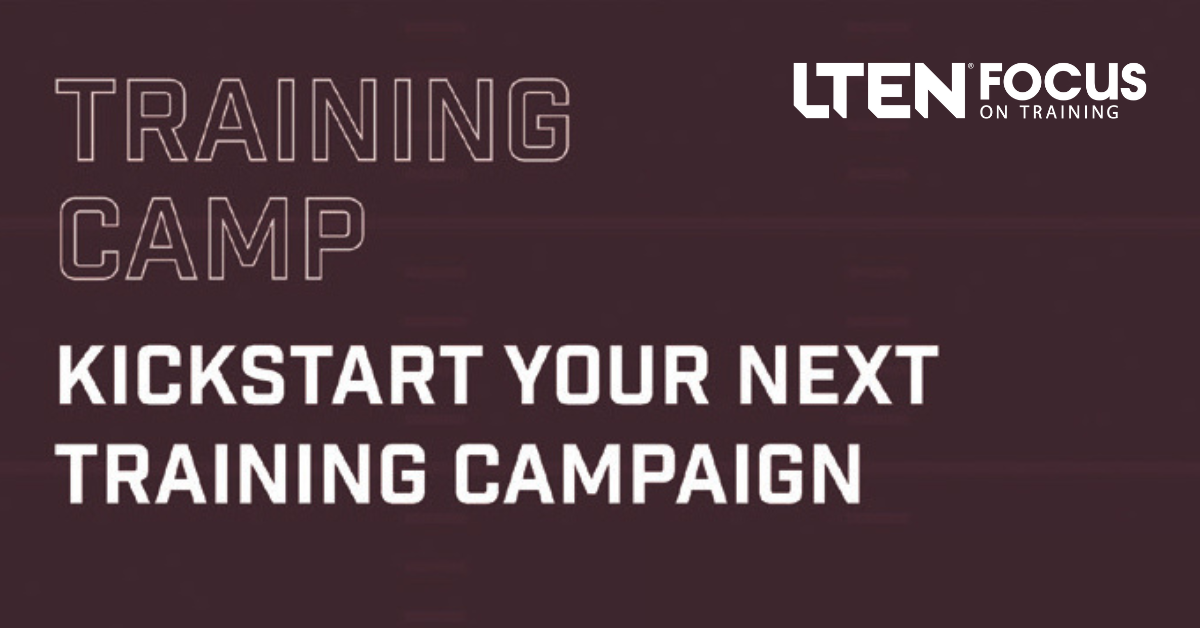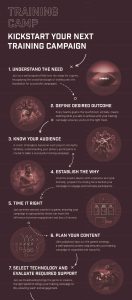
INSTRUCTIONAL DESIGN – By Natalie Ure
Campaigns aren’t just an assortment of tactics
 In many ways, the strategies used to engage customers mirror the ones needed to connect deeply with our learners. It’s about forging meaningful connections, sparking curiosity and driving action.
In many ways, the strategies used to engage customers mirror the ones needed to connect deeply with our learners. It’s about forging meaningful connections, sparking curiosity and driving action.
Just as businesses constantly adapt to better communicate with and cater to their customers, the world of training must innovate to captivate its learners. The blending of communication and training strategies not only engages learners but keeps them truly invested in their journey.
Rather than being a mere trend, this combined approach is the new benchmark, with training campaigns exemplifying this contemporary mindset.
What Are Training Campaigns?
Pinning down a precise definition for training campaigns is challenging due to the many factors involved such as time frame, weekly commitment, creativity, messaging, technology, rewards and alignment with the unique corporate culture.
At their core, training campaigns are a dynamic sequence of carefully coordinated learning activities and experiences aimed to achieve specific outcomes. These campaigns operate within clear start and end dates, serving a dual purpose to educate and excite. By seamlessly blending game mechanics with learning and communication, they turn what can often be a monotonous learning process into a fun experience that resonates with people.
These campaigns aren’t just an assortment of tactics; they’re thoughtfully designed to echo a company’s distinct culture and capture the purpose behind the initiative (the why). Ultimately, training campaigns drive behavioral change and elevate communication strategies to new levels.
Kick-Start Your Training Campaign Design
The design phase sets the foundation for any successful training initiative. It is where strategy transforms into actionable steps.
Training campaigns that truly resonate and drive meaningful change are meticulously crafted from the ground up. By starting with these foundational steps, you pave the way for a training campaign that’s not only engaging but also impactful.
1. Understand the Need
Explain the shifting landscape of training to your stakeholders. In our dynamic world, traditional training may fall short. It’s essential to realize that the primary objective is not just about engagement. The focus should also be on delivering ongoing, relevant, experiential content that ensures retention and promotes actionable learning in a flexible and enjoyable format.
2. Define Desired Outcomes
Before diving in, define the desired outcomes and gain alignment from your stakeholders. Do you want to enhance knowledge retention, drive a behavior change or achieve another objective? Decide on the metrics — quantitative, qualitative or both — that will measure these outcomes.
3. Know Your Audience
The heart of any training campaign is its audience. Recognize your primary participants and immerse yourself in their world. Develop comprehensive profiles that encapsulate their habits, motivations, preferences and pain points. Reflect on their past training and current initiatives, identifying shared experiences or challenges. These insights will become the foundational threads that weave through your campaign.
4. Establish the ‘Why’
Determine what will make people sit up and take notice. What messages strike a chord? What incentives will drive participation and completion? Opt for game mechanics, such as leaderboards or badges, that will resonate with your audience. Don’t forget other motivational factors, such as community, surprise and achievement.
5. Time It Right
Establish the optimal duration for your campaign by considering events, whether virtual or in person, that might complement or interfere with your initiative. Understand how much time your audience can realistically invest on a daily, weekly or monthly basis.
Choose a duration for the campaign that maximizes its effectiveness. Learners can become frustrated when durations are too short to be effective and overwhelmed when they are unnecessarily long.
6. Plan Your Content
Assess existing content that can bolster your campaign. Identify gaps that require new content and decide on the formats (for example, videos, quizzes, microlearning, articles or activities) that align best with your goals and the preferences of your audience.
7. Select Technology & Evaluate Required Support
Choose the right platform that aligns with your vision for the training campaign and evaluate if external agency partner support is needed to bring your vision to life.
When it comes to tech, prioritize ease of access. Aim for a one-stop-shop experience where users can effortlessly find everything they need in a few clicks. Clearly define and communicate support requirements for your campaign and achieve buy-in from the appropriate stakeholders.
8. Champion Your Campaign
The effectiveness of your campaign isn’t just about the experiences you offer, but also about who promotes and champions it within the organization. Identify internal champions, such as field ambassadors, who can vouch for the campaign’s value. Secure manager endorsements to inspire teams and bolster participation.
Call to Action
The time to act is now! As an industry, we invest in methods that are adaptive, engaging and enduring. For trainers and educators, the message is clear: Dare to innovate, blend classic and contemporary approaches and always align your strategies with the desired outcomes.
After all, our mission in learning and development is to ensure we design meaningful experiences that create a lasting impact.
 Natalie Ure is a freelance learning experience designer. Email Natalie at natalie@hurleyconsultingllc.com or connect with her through www.linkedin.com/in/natalie-ure.
Natalie Ure is a freelance learning experience designer. Email Natalie at natalie@hurleyconsultingllc.com or connect with her through www.linkedin.com/in/natalie-ure.








